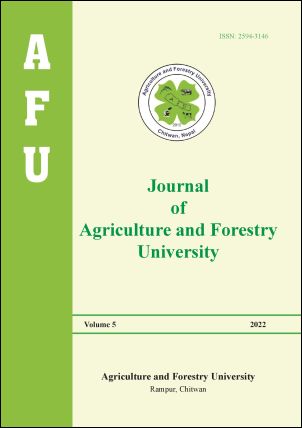Distribution of isoflavone and pinitol content in different parts of Serica lespedeza
DOI:
https://doi.org/10.3126/jafu.v5i1.48450Keywords:
Sericea lespedeza, isoflavone, pinitolAbstract
Isoflavone is an important functional component that is associated with human health benefits such as the decreased risk of heart disease, menopausal symptoms, cardiovascular disease, and bone resorption as well as breast, prostate, and colon cancers. Pinitol (also referred to as D-Pinitol) is a type of sugar and classified as a chiro-inositol (sugar alcohol), has been demonstrated to exert insulin-like, anti-inflammatory and a hypoglycemic effect (to reduce blood sugar level). Sericea lespedeza (Lespedeza cuneata) species were collected from the different parts of Korea in the autumn season of 2011 and analyzed the isoflavone and pinitol content of leaves and stems by High-Performance Liquid Chromatography (HPLC). A large variation of isoflavone and pinitol content in the leaves and stems of lespedeza species was observed. The average isoflavone content of leaves and stems were 1,612 and 873 μg/g and ranged from 44 ~ 6,536 and 25 ~ 3,666 μg/g, respectively. Similarly, the average pinitol content of leaves and stems were 15,195 and 9,104 μg/g and ranged from 5,049 ~ 35,289 and 1284 ~ 27,185 μg/g, respectively. Both isoflavone and pinitol content in the leaves were significantly higher than in the stems. Leaves of sericea lespedeza showed unexpectedly higher isoflavone and pinitol. The average isoflavone content in leaves and stems among nine provinces were also significantly different. The highest isoflavone content in leaves (6,536 μg/g) and stems (3,666 μg/g) were measured in the samples collected from Chungcheongnam and Gangwon provinces, respectively. Similarly, the highest pinitol content in the leaves (35,289 μg/g) and stems (27,185 μg/g) were measured in the samples collected from Gyeonggi and Gangwon provinces, respectively. The genotypes with high isoflavone and pinitol content especially in the leaves of this medicinal herb could be used as elite genetic resources for food industries to make quality functional food products as well as medicines especially for diabetes.
Downloads
Downloads
Published
How to Cite
Issue
Section
License
Copyright (c) 2022 Agriculture and Forestry University (AFU), Rampur, Chitwan, Nepal

This work is licensed under a Creative Commons Attribution-NonCommercial 4.0 International License.
This license allows reusers to distribute, remix, adapt, and build upon the material in any medium or format for noncommercial purposes only, and only so long as attribution is given to the creator.




